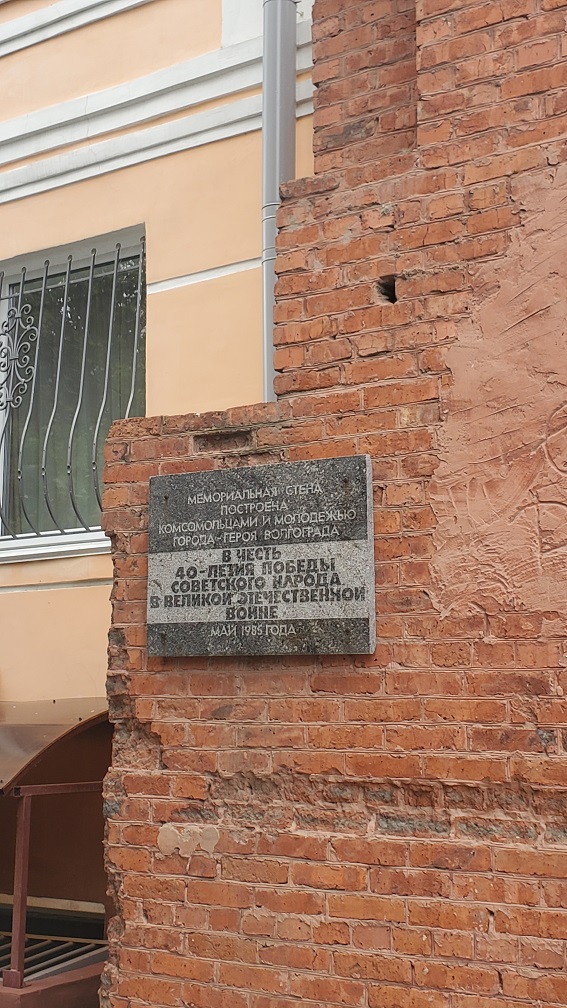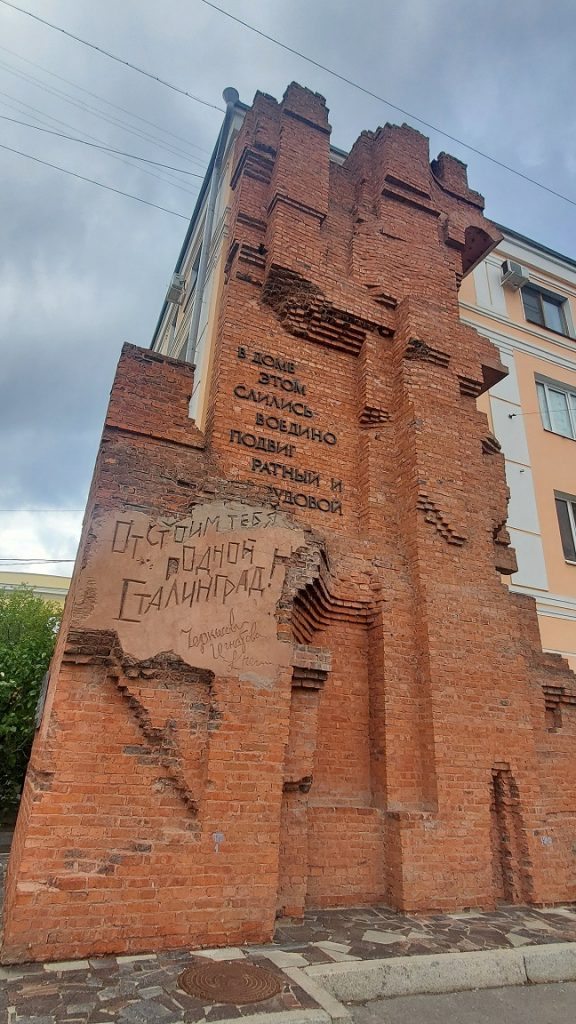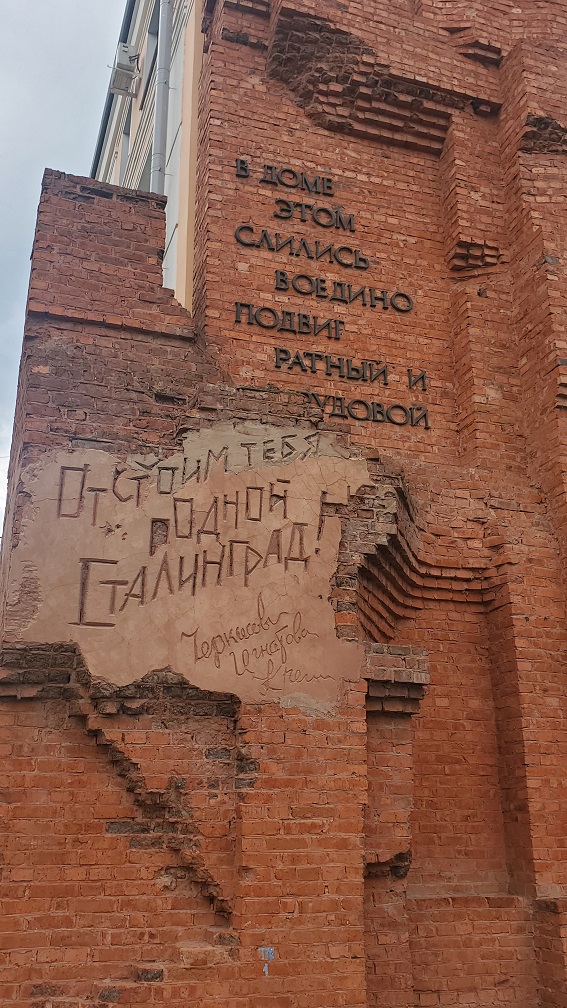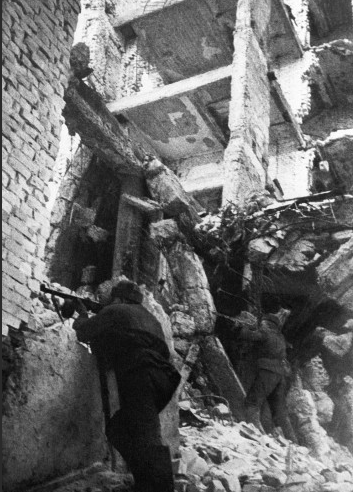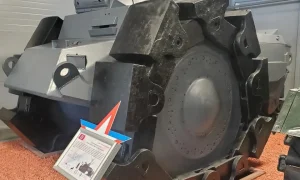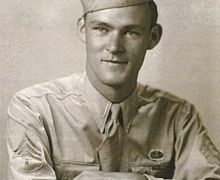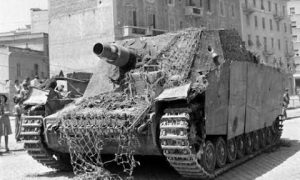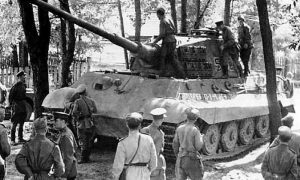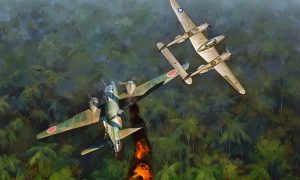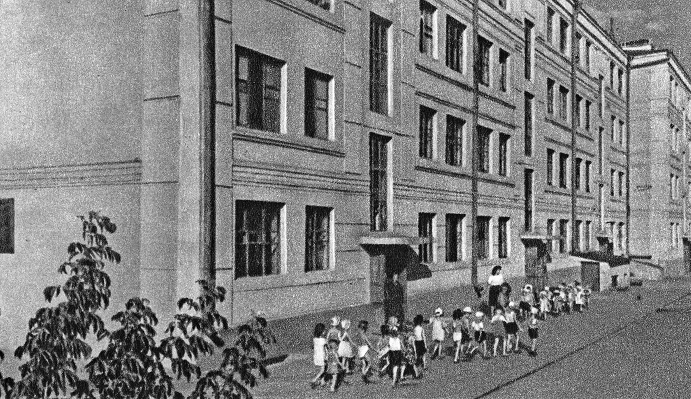
Pavlov’s House is a 4-storey residential building located on Lenin Square in Volgograd , in which a group of Soviet soldiers heroically defended during the Battle of Stalingrad for 58 days. Some historians believe that the defense was led by senior sergeant Ya. F. Pavlov , who took command of the squad from senior lieutenant IF Afanasyev , who was wounded at the beginning of the battle, hence the name of the house. However, there is another version that Ya. F. Pavlov was the commander of the assault group that seized the building, and the defense was led by senior lieutenant IF Afanasyev.
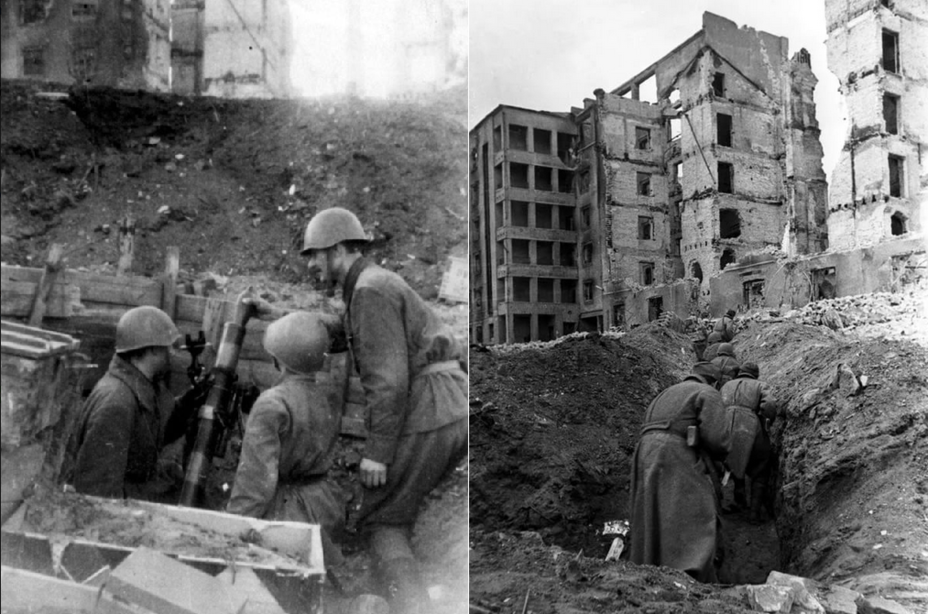
Before the war
The four-storey residential building with four entrances of the Regional Consumer Union at 61 Penzenskaya Street on 9th January Square (now Lenin Square ) was built in the mid-1930s by the architect Sergei Voloshinov . This house was considered one of the most prestigious in Stalingrad, next to it were elite residential buildings: the House of Signalers, the House of the NKVD workers, the House of Railwaymen and others. Specialists from industrial enterprises and party workers lived in Pavlov’s house. Nearby was also the House of Sovkontrol – the future House of Zabolotny – a mirror copy of the Pavlov House. These two buildings will play an important role in the defense of the 9th January Square. According to eyewitnesses, the color of both buildings was green. Between these houses there was a branch of the railway to Gosmelnitsa No. 4 ( Grudinin’s mill).
Stalingrad battle
On September 27, 1942, as a result of bombing by German aircraft, the architect of the house, Sergei Voloshinov, and his pregnant wife were killed .
In the area of the 9th January Square, the 42nd Guards Rifle Regiment of the 13th Guards Division defended… The regiment commander, Colonel Yelin, instructed Captain Zhukov to carry out an operation to seize two important residential buildings. Two groups were created: the group of Lieutenant Zabolotny and Sergeant Pavlov, who captured these houses. Zabolotny’s house was subsequently burned out and blown up by the advancing Germans. He collapsed along with the fighters who defended him. A reconnaissance and assault group of four soldiers, led by Sergeant Pavlov (it included Red Army men A.P. Aleksandrov, V.S.Glushchenko, N.Ya. it turned out, but it was a difficult task to get into the house, since all approaches to it were tightly shot by the Germans) and entrenched in it. In the basements of the house were civilians and with them the medical instructor of the 3rd battalion of the same regiment, the Red Army soldier S.S.Kalinin, whom Pavlov sent with a report to the regiment headquarters).
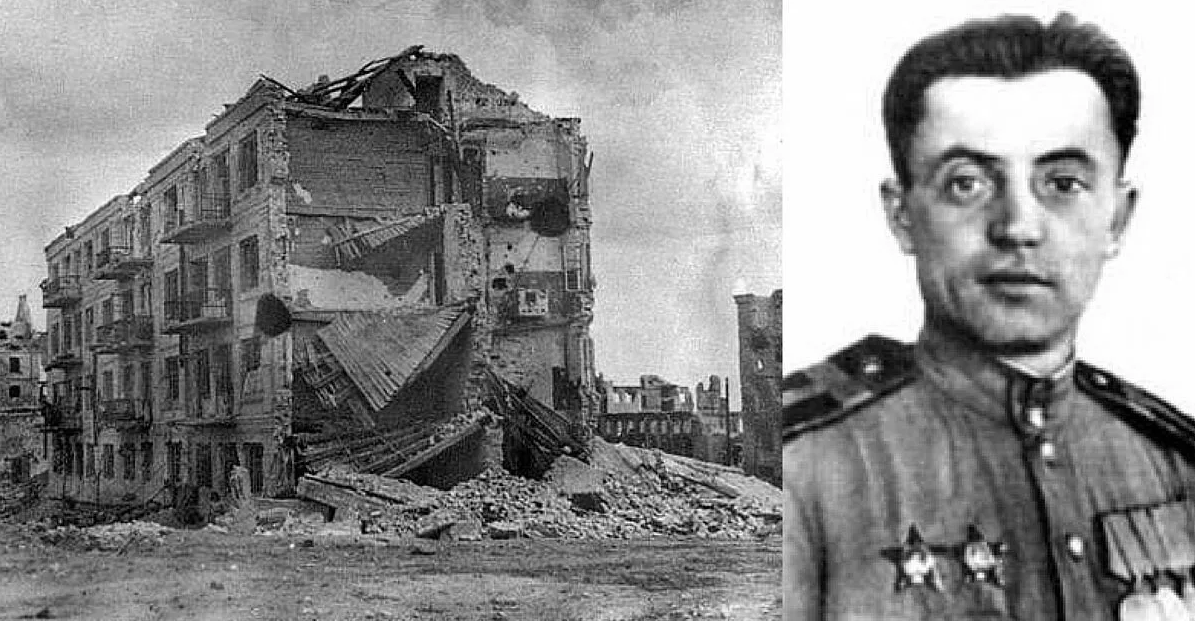
On the third day, reinforcements arrived at the house under the command of Senior Lieutenant Afanasyev (17 fighters, another Red Army soldier was wounded on the way and returned to the regiment’s positions), delivering a heavy machine gun and 3 anti-tank rifles with ammunition, and the house became an important stronghold in the regiment’s defense system and all 13 Guards. page division . From that moment, Senior Lieutenant Afanasyev began to command the defense of the building. A few days later, a group of junior lieutenant A. Chernyshenko (4 soldiers and 2 company mortars ) arrived at the house . The garrison was subordinate to the commander of the 7th rifle company of the 42nd Guards rifle regiment, senior lieutenant II Naumov, whose command post was at the main position of the company, but he often visited the Pavlov House and repeatedly participated in repelling attacks along with his defenders.
In the very first nights, an impromptu garrison turned the house into a stronghold of defense (which in many ways contributed to its further successful defense): the approaches to the building from the side of German positions were mined, the house was surrounded by a wire fence, sheltered firing points were created outside the house, a deep passage was dug from the house to the positions of the regiment for the delivery of ammunition and A telephone line completely hidden under the ground, narrow embrasures were made for firing in the windows and in the walls, and the soldiers prepared several reserve positions for each firearm. The house was included in the regiment’s fire defense system, the approaches to it were shot by Soviet soldiers from three directions, and the approaches to neighboring positions were also shot from the “Pavlov’s House”. That is, “Pavlov’s House” was not a kind of separate isolated object, as some authors sometimes describe its defense. During the days of defense, it was visited by the commander 13th Guards Division, Guards Colonel A.I. Rodimtsev , the entire command of the 42nd Guards Rifle Division and the 3rd battalion of this regiment.
According to the memoirs of Wilhelm Adam , Colonel Roske told him that German assault groups captured the lower floor of the building, but could not capture it entirely. For the Germans it was a mystery how the garrison on the upper floors was supplied.
The first 30 days of defense were especially difficult, when the Germans tried to recapture the building every day. The Germans organized attacks several times a day. Every time when soldiers or tanks tried to get close to the house, IF Afanasyev and his comrades met them with heavy fire from the basement, windows and roof; they were supported by fire from the main positions of the regiment. An artillery fire point was set up on the top floor, where a group of artillery observers headed by an officer came daily.
During the defense of Pavlov’s house (from September 23 to November 25, 1942), there were civilians in the basement until the Soviet troops launched a counterattack.
Of the 31 defenders of Pavlov’s house, three were killed during his defense – lieutenant – mortarman A.N. Chernyshenko, sergeant I. Ya. Hait and private I. T. Svirin. Both Pavlov and Afanasyev were wounded, but both Pavlov and Afanasyev survived the war.
The defense of this house alone lasted 58 days.
What were the losses of the Germans in numerical terms, the sources do not report; and it is unlikely that information on losses at this point could be highlighted in the German reports. Marshal V. Chuikov said in his memoirs: “This small group, defending one house, destroyed the enemy soldiers more than the Nazis lost in the capture of Paris”.
Defenders of the Pavlov House
Data on the number of defenders range from 24 to 31 (about 50 people once claimed the name of the Unknown Soldier who defended the House of Soldiers’ Glory). More than thirty civilians were also in the basements, some were seriously injured as a result of fires that broke out after the attacks of German artillery.
| No. | FULL NAME. | Title / position | Armament | Nationality |
| 1 | Pavlov Yakov Fedotovich | sergeant
machine gun squad commander |
submachine gun | Russian |
| 2 | Glushchenko Vasily Sergeevich | corporal | light machine gun | Ukrainian |
| 3 | Alexandrov Alexander | Red Army soldier | light machine gun | Russian |
| 4 | Chernogolov Nikita Yakovlevich | Red Army soldier | light machine gun | Russian |
| 5 | Afanasiev Ivan Filippovich | lieutenant
machine gun platoon commander (garrison commander) |
Maxim machine gun | Russian |
| 6 | Alexey Nikiforovich Chernyshenko † | ml. lieutenant
commander of the mortar squad |
mortar | Ukrainian |
| 7 | Gridin Terenty Illarionovich | sergeant | mortar | Russian |
| 9 | Voronov Ilya Vasilievich | Art. sergeant
commander of the machine-gun crew |
Maxim machine gun | Russian |
| 9 | Hait Idel Yakovlevich † | sergeant | submachine gun | Jew |
| 10 | Ivaschenko Alexey Ivanovich | sergeant | Maxim machine gun | Ukrainian |
| 1 | Svirin Ivan Timofeevich † | Red Army soldier | light machine gun | Russian |
| 12 | Bondarenko Mikhail | Red Army soldier | light machine gun | Ukrainian |
| 13 | Dovzhenko Pavel. AND. | Red Army soldier | Maxim machine gun | Ukrainian |
| 14 | Sobgaida Andrey | Art. sergeant
commander of the armor-piercing squad |
PTR | Ukrainian |
| 15 | Ramazanov Faizrakhman Zulbukarovich | corporal | PTR | Tatar |
| 16 | Yakimenko Grigory Ivanovich | Red Army soldier | PTR | Ukrainian |
| 17 | Murzaev Talibay | Red Army soldier | PTR | Kazakh |
| 18 | Turdyev Mabulat | Red Army soldier | PTR | Tajik |
| 19 | Turgunov Kamolzhon | Red Army soldier | PTR | Uzbek |
| 20 | Kiselev V.M. | Red Army soldier | submachine gun | Russian |
| 21 | Mosiashvili Niko | Red Army soldier | submachine gun | Georgian |
| 22 | Saraev V.K. | Red Army soldier | submachine gun | Russian |
| 23 | Shapovalov Andrey Egorovich | Red Army soldier | submachine gun | Russian |
| 24 | Khokholov Garya Badmaevich | red
army sniper |
rifle | Kalmyk |
| The reconnaissance group of Sergeant Pavlov Ya.F., which seized the building | |
| Mortar squad | |
| Machine gun crew of Art. Sergeant Voronov I.V. | |
| Armor-piercing squad |
Among the defenders of the garrison, who were in the building not constantly, but only periodically, were sniper sergeant Anatoly Ivanovich Chekhov and medical instructor Maria Stepanovna Ulyanova, who took up arms during the German attacks.
The last of the Red Army defenders of the Pavlov House during the Battle of Stalingrad died an ATR shooter Kamolzhon Turgunov from the village of Bardankul, Turakurgan district of the Namangan region of the Republic of Uzbekistan (he died on March 16, 2015 at the 93rd year of his life in his homeland) and a shooter Duisenov Kalambay from the village of Merke, Zhambul region of the Republic of Kazakhstan (died on May 4, 2006).
Anatoly Nikolaevich Kuryshov, who defended the legendary Pavlov House at the age of 11, is the only living hero out of 25 who took part in this event now living in Komsomolsk-on-Amur.
Sergeant Yakov Fedotovich Pavlov was awarded the title of Hero of the Soviet Union on June 27, 1945 by a decree of the Presidium of the Supreme Soviet of the USSR for a feat accomplished back in Stalingrad.
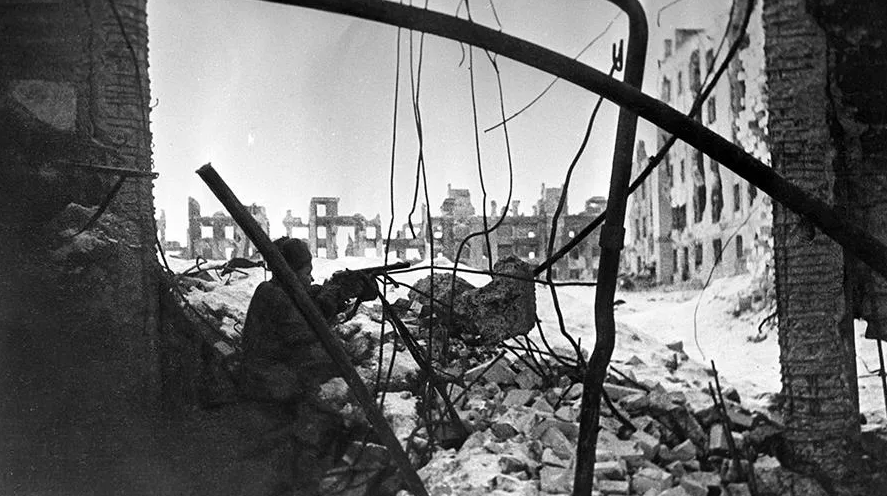
After the war
The house, held by the garrison of Senior Lieutenant IF Afanasyev, is considered the first restored building in Stalingrad. The official restoration of the house began on June 9, 1943.
With the restoration of the house, the Cherkassov movement began. The feat of the defenders of Pavlov’s house is immortalized with a memorial wall on the end wall of the house from the side of the square. The inscription on it reads:
On May 4, 1985, a memorial wall-monument was unveiled on the end wall of the house from the side of Sovetskaya Street. The authors are architect V. E. Maslyaev and sculptor V. G. Fetisov . The inscription on the memorial wall reads: “In this house, the feat of war and labor merged into one.”
